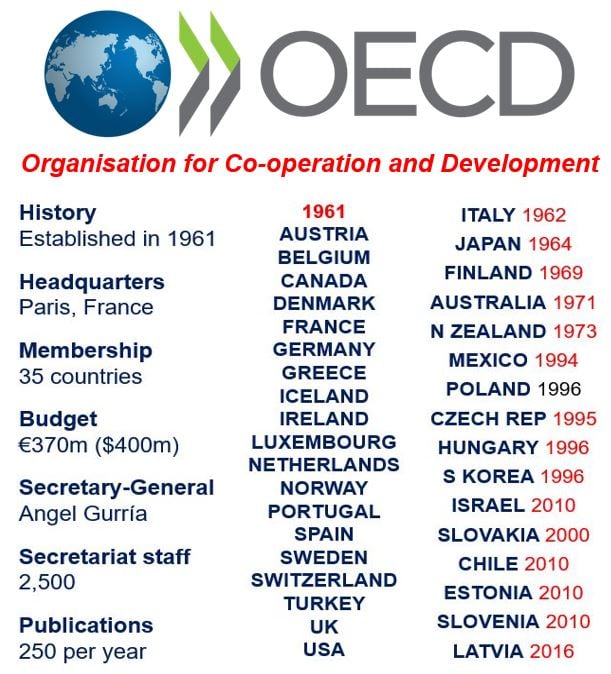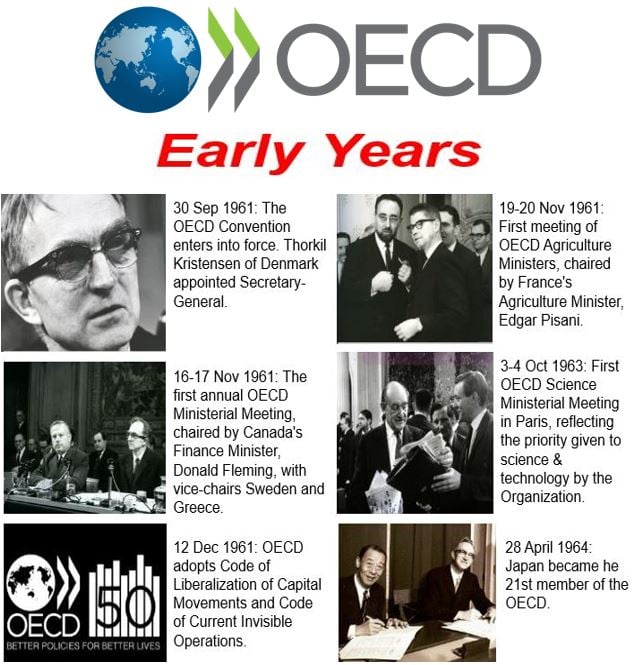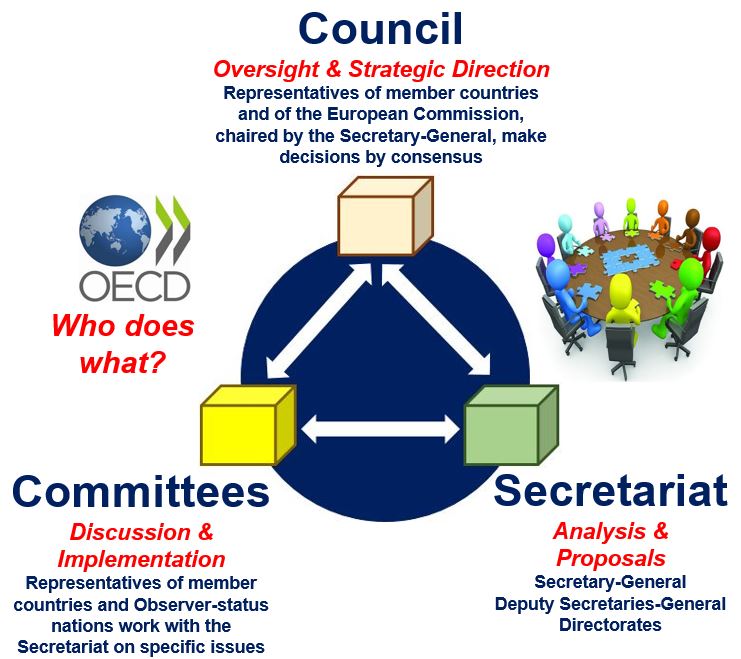The OECD stands for the Organisation for Economic Co-operation and Development. The definition and meaning is a Paris based club representing thirty-five countries, most of them advanced economies, plus some leading emerging nations. The OECD, formed in 1961, was built on the OEEC (Organization for European Economic Cooperation), which emerged during the Marshall Plan. The Marshall Plan was a US/Canadian financial aid program to help European nations get back on their feet after World War II.
There are two possible spellings: 1. Organization (US). 2. Organisation (British). Unlike the United Nations system, the OECD uses Organisation. Even though Market Business News is a British publication, we use the US spelling in our articles because North America represents over 60% of our readers.
The OECD nations’ combined GDPs (gross domestic products) represent approximately two-thirds of the world’s total. Its main aim is to encourage and stimulate world trade and economic progress.

OECD Members are Market Economies
All OECD member states claim to be market economies that are committed to democracy. The organization says it provides a platform where they:
- Share and compare policy experiences.
- Identify good practices.
- Coordinate members’ international and domestic policies.
- Seek answers to common problems.
The OECD makes the following comment on its website about its mission:
“The mission of the Organization for Economic Co-operation and Development (OECD) is to promote policies that will improve the economic and social well-being of people around the world.”
“The OECD provides a forum in which governments can work together to share experiences and seek solutions to common problems. We work with governments to understand what drives economic, social and environmental change. We measure productivity and global flows of trade and investment.”
“We analyze and compare data to predict future trends. We set international standards on a wide range of things, from agriculture and tax to the safety of chemicals.”

The organization also looks at issues that affect all our daily lives directly, like how much leisure time we can take, and how much we pay in taxes and social security.
It compares how effectively each member state’s education system is preparing its young citizens for modern life, and how well their pension systems will look after their elderly citizens.
OECD – a brief history
OEEC
In 1948, the OEEC was formed to administer the Canadian and American Marshall plan, a program created to rebuild a devastated Europe after WWII. The OEEC was based in the Château de la Muette, Paris, France.
When the Marshall Plan was completed, the OEEC turned its focus to economic issues. In the 1950s it was closely involved in determining the conditions for the creation of a European Free Trade Area. The European Nuclear Energy Agency was formed under the OEEC in 1958.
Europe was effectively rebuilt by the end of the 1950s. By then, European and North American policymakers felt that the OEEC had served and outlived its purpose, but should be adapted to serve a more worldwide mission.
Decision to create a new body
After several lengthy discussions and negotiations, a resolution was reached at the Hotel Majestic in Paris, in January 1960, to create a body that would deal with policies to assist both the advanced and less developed economies of the world.
This reconstituted body brought Canada and the United States, which were already OEEC observer nations, on board as full members.
The Rome Treaties to launch the EEC (European Economic Community) – which eventually became the current European Union – were signed in 1957. In the same year, the Convention on the Organisation for Economic Co-operation and Development was drawn up to reform the OEEC.
OECD replaced OEEC
The OECD officially replaced the OEEC in September 1961. The founding members were: The United States, The United Kingdom, Turkey, Switzerland, Sweden, Spain, Portugal, Norway, the Netherlands, Luxembourg, Italy, Ireland, Iceland, Greece, West Germany, France, Denmark, Canada, Belgium and Austria.
By 1976, New Zealand, Australia, Finland and Japan had joined the OECD. Between 1994 and 2000, Mexico, South Korea, Slovakia, the Czech Republic, Hungary and Poland became member states. Chile, Estonia, Israel and Slovenia joined in 2010.
Russia about to join, but..
Talks with Russia to become an OECD member state were halted in March 2014, after the country annexed the Crimea.

OECD – who does what?
Council
The Council is vested with the organisation’s decision-making power. Each member state has one representative. The **European Commission also has a representative.
** Part of the European Union, the European Commission is responsible for proposing new legislation, implementing decisions, upholding the EU treaties, and managing the bloc’s day-to-day business.
The Council meets frequently at member-state-representative level. Decision are taken by consensus (general agreement). Each meeting is chaired by the OECD Secretary-General.
Each year, there is a ministerial level meeting where key issues are discussed and priorities set for OECD work The Secretariat carries out the work mandated by the Council.

Committees
Member-country representatives meet in specialized committees, where they advance ideas, and review or assess progress made in specific policy areas such as education, financial markets, employment, trade, science, and economics.
The OECD currently has approximately 250 committees, expert groups and working groups. Each year, about 40,000 senior officials from member states’ administrations go to committee meetings to contribute to, request and review work undertaken by the organization’s Secretariat.
Back home, the senior officials and their team members have online access to documents and can exchange data through a special network.
Life expectancy in #OECD countries has risen by over a decade since 1970s,yet large health inequalities persist &new challenges are emerging pic.twitter.com/5Cn7dfYMmd
— Angel Gurría (@A_Gurria) 17 January 2017
Secretariat
The Secretariat is headed by the OECD’s current Secretary-General, Angel Gurría. He is assisted by Deputies Secretaries-General. Mr. Gurría is also chairman of the Council, providing the link between national delegations and the Secretariat.
The Secretariat, based in Paris, consists of approximately 2,500 employees who support the committees’ activities, and carry out the work in response to the OECD Council’s decisions.
The Secretariat employs lawyers, economist, scientists, statisticians and other professionals. The vast majority of employees work in Paris, but some are based at a number of OECD centers across the world.
Video – All about the OECD
This World Brain video explains what the OECD is and how it came about.
